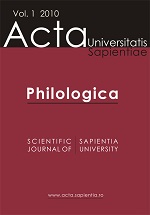Historical, Social and Cultural Setting for Romanian-Hungarian Contacts in 16th-Century Transylvania
Historical, Social and Cultural Setting for Romanian-Hungarian Contacts in 16th-Century Transylvania
Author(s): Judit PálSubject(s): Language and Literature Studies
Published by: Scientia Kiadó
Keywords: space in ethnic contacts; Transylvania; Romanian-Hungarian symbiosis; cultural influence
Summary/Abstract: All around the world there are different communities or language groups with specific contacts that influence each other’s development. Theoretically we might delimitate homogeneous communities, practically, however, these would be only mental constructs as all groups are essentially heterogeneous. Even amongst communities that speak the same language and share the same culture there will be individual differences. One specific type of contact between two nations is that between a minority and the majority. My research focuses on this particular issue, referring to the contacts between Romanians and Hungarians in a peculiar geographical setting: Transylvania. Not only this space but also other factors (i.e. temporal, economic, etc.) play an important role in these contacts. During many centuries Romanians and Hungarians lived in symbiosis, especially in Transylvania, which led to numerous mutual influences: not only social or cultural ones but on linguistic level as well. My paper regards mainly the Hungarian influence on the Transylvanian Romanian society in that period. Thus, we can outline the influence upon the Romanian social system, their lifestyle or confessional / religious orientation, folk art and, generally, upon the Romanian language vocabulary (see the relation between Reformation and the first texts written in Romanian). All these were provided by geographical, historical and political factors that characterised Transylvania in the 16th century.
Journal: Acta Universitatis Sapientiae, Philologica
- Issue Year: 4/2012
- Issue No: 2
- Page Range: 357-372
- Page Count: 16
- Language: English

